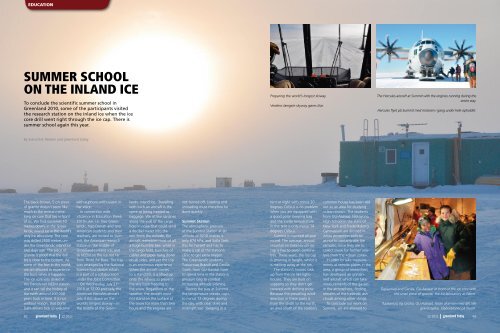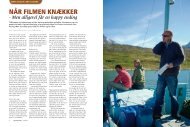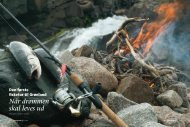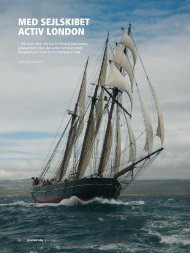suMMEr sCHool oN tHE iNlANd iCE - Greenland Today
suMMEr sCHool oN tHE iNlANd iCE - Greenland Today
suMMEr sCHool oN tHE iNlANd iCE - Greenland Today
Create successful ePaper yourself
Turn your PDF publications into a flip-book with our unique Google optimized e-Paper software.
EDUCATION<br />
<strong>suMMEr</strong> <strong>sCHool</strong><br />
<strong>oN</strong> <strong>tHE</strong> <strong>iNlANd</strong> <strong>iCE</strong><br />
To conclude the scientifi c summer school in<br />
<strong>Greenland</strong> 2010, some of the participants visited<br />
the research station on the inland ice when the ice<br />
core drill went right through the ice cap. There is<br />
summer school again this year.<br />
By Svend Erik Nielsen and greenland today<br />
The black-brown, 5 cm piece<br />
of granite doesn’t seem like<br />
much in the several metre<br />
long ice core that lies in front<br />
of us. We fi nd ourselves 10<br />
metres down, in the <strong>Greenland</strong>ic<br />
inland ice in the world’s<br />
only ice laboratory. The core<br />
was drilled 2500 metres under<br />
the <strong>Greenland</strong>ic inland ice<br />
two days ago. The piece of<br />
granite is proof that the drill<br />
bit is close to the bottom. As<br />
some of the few in this world,<br />
we are allowed to experience<br />
the buzz when it happens.<br />
The ice core was drilled at<br />
the Danish-run NEEM station<br />
and it can tell the history of<br />
the earth around 200,000<br />
years back in time. It is not<br />
without reason, that Dorte<br />
Dahl-Jensen bids us welcome<br />
with euphoric enthusiasm in<br />
her voice.<br />
In connection with<br />
»Science in Education Week<br />
2010« we, i.e. two <strong>Greenland</strong>ic,<br />
two Danish and two<br />
American students and their<br />
teachers, are invited to Summit,<br />
the American research<br />
station in the middle of<br />
<strong>Greenland</strong>’s inland ice, and<br />
to NEEM on the ice not far<br />
from Thule Air Base. The trip<br />
was arranged by the National<br />
Science Foundation which<br />
is a part of a collaboration<br />
under the Joint Committee.<br />
On Wednesday, July 21 st<br />
2010 at 12.00 precisely, the<br />
American Hercules aircraft<br />
sets it skis down on the<br />
world’s longest skiway – in<br />
the middle of the Green-<br />
landic inland ice. Travelling<br />
with such an aircraft is the<br />
same as being treated as<br />
baggage. We sit like sardines<br />
along the wall of the cargo<br />
hold in noise that could send<br />
a decibel meter into the<br />
red. From the outside, the<br />
aircraft resembles most of all<br />
a huge bumble bee, while in<br />
the cargo hold, bunches of<br />
cables and pipes hang down<br />
on all sides, and yet the trip<br />
is an enormous experience.<br />
When the aircraft comes<br />
to a standstill, it is lifted up<br />
onto the wheels to prevent<br />
the skis from freezing to<br />
the snow. Regardless of the<br />
weather, the aircraft must<br />
not stand on the surface of<br />
the snow for more than two<br />
hours and the engines are<br />
not turned off. Loading and<br />
unloading must therefore be<br />
done quickly.<br />
Summit Station<br />
The atmospheric pressure<br />
at the Summit Station at an<br />
altitude of 3210 metres is<br />
only 674 hPa, and Sofi e feels<br />
this for herself and has to<br />
make a call at the station’s<br />
clinic to get extra oxygen.<br />
The <strong>Greenland</strong>ic students<br />
Tupaarnaq Brandt and Cecilia<br />
Groth from GU-Aasiaat have<br />
to spend time in the station’s<br />
pressure bag to combat<br />
increasing altitude sickness.<br />
During the stay at Summit<br />
the temperature sneaks »up«<br />
to minus 12 degrees during<br />
the day, with clear skies and<br />
midnight sun. Sleeping in a<br />
Preparing the world’s longest skiway.<br />
Verdens længste skyway gøres klar.<br />
tent at night with minus 20<br />
degrees Celsius is no problem<br />
when you are equipped with<br />
a good polar sleeping bag<br />
and the inside temperature<br />
in the tent is only minus 14<br />
degrees Celsius.<br />
Summit is manned all year<br />
round. The average, annual<br />
snowfall on <strong>Greenland</strong>’s ice<br />
cap is fi ve to seven centimetres.<br />
These years, the ice cap<br />
is growing in height, whilst it<br />
is melting away at the rim.<br />
The station’s houses stick<br />
up from the ice like lighthouses.<br />
They are built on<br />
supports so they don’t get<br />
covered with drifting snow.<br />
Because the prevailing wind<br />
direction in these parts is<br />
from the south to the north,<br />
an area south of the station’s<br />
common house has been laid<br />
out as an area for studying<br />
»clean snow«. The students<br />
from GU-Aasiaat, Niskayuna<br />
High School in the state of<br />
New York and Frederiksborg<br />
Gymnasium are dressed in<br />
white protection suits so<br />
as not to contaminate the<br />
samples, since they are to<br />
collect snow for further analysis<br />
from the »clean zone«.<br />
In order to take measurements<br />
at remote places in the<br />
area, a group of researchers<br />
has developed an unmanned<br />
aircraft which can take<br />
measurements of the gasses<br />
in the atmosphere, fi nding<br />
remains of the Icelandic ash<br />
clouds among other things.<br />
To conclude our work on<br />
Summit, we are allowed to<br />
The Hercules aircraft at Summit with the engines running during the<br />
entire stay.<br />
Hercules fl yet på Summit med motoren i gang under hele opholdet.<br />
Tupaarnaq and Cecilia, GU-Aasiaat in front of the ice core with<br />
the small piece of granite, the ice laboratory at Neem.<br />
Tupaarnaq og Cecilia, GU-Aasiaat, foran iskernen med det lille<br />
granitstykke, Islaboratoriet på Neem.<br />
62 greenland today 12 2011 12 2011<br />
greenland today 63
assist in sending up a large balloon<br />
with equipment for measuring<br />
ozone. The balloon is<br />
filled with helium and it moves<br />
up through the atmosphere to<br />
an altitude of 30 km and we<br />
can constantly follow the information<br />
about the ozone<br />
concentration and temperature.<br />
NEEM Station<br />
Following the stay at the Summit<br />
Station we are supposed<br />
to go directly to the Danishrun<br />
ice core drilling station at<br />
77<br />
64 greenland today 12 2011 12 2011 greenland today 65<br />
o JoiNt CoMMittEE<br />
The Joint Committee cooperation is built<br />
on a cooperation agreement signed in<br />
South <strong>Greenland</strong> in 2004 by Denmark,<br />
USA and <strong>Greenland</strong> and therefore called<br />
the »Igaliko agreement«.<br />
One of the purposes is to promote<br />
cooperation between <strong>Greenland</strong> and<br />
the USA with regard to research, health,<br />
technology, energy, environment, education,<br />
tourism, traffic and trade.<br />
The piece of granite in the ice core at Neem.<br />
sErMErsuAq<br />
Sermersuaq – the great ice – is the<br />
<strong>Greenland</strong>ic name for the inland ice.<br />
The inland ice is mother to the white<br />
Granit stykket i iskernen fra Neem.<br />
ice giants of the ocean and it is gigantic<br />
itself. From north to south the inland ice<br />
Wine rack in the ice laboratory at Neem.<br />
stretches more than 2,600 kilometres<br />
– the same as the distance from Scandinavia<br />
to northern Africa and it reaches a<br />
Vinreol i islaboratoriet på Neem.<br />
thickness of more than three kilometres.<br />
NEEM - drilliNg AN <strong>iCE</strong> CorE<br />
The <strong>Greenland</strong>ic inland ice is a unique<br />
The drill used for the NEEM ice core drilling is a self-contained<br />
database which can be used to study<br />
unit only connected to the surface by an steel cable. Inside the<br />
the climate of the past. The snow that Provisions are moved by a chain of humans to Proviant transporteres via menneskekæde til<br />
cable, power for the drill is transmitted together with control<br />
falls on the inland ice is covered by the the kitchen in the common house.<br />
køkkenet i fælleshuset.<br />
commands from the operators. The drill is about 13.5 meters<br />
following year’s snowfall and is thereby<br />
long, cuts away a ring of ice approx. 2 cm wide with an inner<br />
gradually changed into ice as a conse-<br />
diameter of 98 mm. when it slides into the inner core barrel.<br />
quence of the pressure from the above-<br />
NEEM stands for North Summer School 2011<br />
The drill contains up to 4 meter of ice core. After a section<br />
lying snow. Over thousands of years the<br />
<strong>Greenland</strong> Eemian Ice dril- <strong>Greenland</strong>ic, Danish and<br />
has been drilled, rotation is stopped, and the cable is pulled.<br />
layers of ice are then pressed deeper<br />
ling. (Eem was a warm, American students will again<br />
Small spring-loaded knives - »core-catchers« - cut into the<br />
and deeper down.<br />
interglacial period of about this year have the oppor-<br />
ice core and prevents it from gliding out of the drill. A force<br />
The fantastic thing is that each year’s<br />
3,000-4,000 years, about tunity to learn about polar<br />
corresponding to a drag of 400-1000 kg is needed to break<br />
ice lies like a growth ring in a tree and<br />
131,000 years ago ed.). research on the inland ice.<br />
the ice core, which is then brought to surface, where the drill<br />
each year’s ice layer contains informa-<br />
At NEEM a number of In the middle of July the<br />
is disassembled, and the core is pushed backwards out of the<br />
tion about the temperature from the<br />
analyses are made of ice students and their teachers<br />
inner core barrel.<br />
time when the snow fell. It is this way, it<br />
cores and work is hectic in will visit the two research<br />
Drilling trough the about 2½ km of ice at NEEM requires<br />
is possible to follow climate fluctuations<br />
the large ice laboratory. The stations, NEEM and Summit.<br />
8-900 drill runs, each taking from 40 minutes to several hours<br />
back in time.<br />
ice cores are sent to the ice Until then, 16 Greenlan-<br />
depending on the depth.<br />
The white colour of the ice is due to<br />
archives at the Niels Bohr dic students, three Danish<br />
air bubbles which are trapped under<br />
Institute in Copenhagen for students and five American<br />
Source : NEEM.DK / University of Copenhagen<br />
the process of transforming snow into<br />
further analysis.<br />
students will take part in<br />
ice under pressure. Many icebergs are<br />
Being at NEEM at precisely Kangerlussuaq Scientific Field<br />
NEEM - At borE EN iskErNE<br />
often transversed by green, turquoise or<br />
this time is not just »been School. They will investigate<br />
Boret, der bruges til at bore NEEM-iskernen, er en komplet<br />
blue bands of pure water ice. The bands N. But the weather gods there, seen that, done that the scientific aspects of na-<br />
enhed, der kun er forbundet med overfladen via et stålkabel.<br />
are formed in the glacier, in places that do not agree and we have to …« – not even if the visit lature around Kangerlussuaq.<br />
Kablet leder strøm til boret samt styrekommandoer fra bo-<br />
have melted and then frozen again with make a detour via Kangerlussted little more than an hour. Summer School is the<br />
reoperatøren. Boret er ca. 13,5 meter langt og skærer en cirka<br />
air bubble-free meltwater.<br />
suaq before we can land on Watching ice, that is perhaps result of an initiative taken<br />
to cm bred ring af is væk. Den indre diameter af denne ring<br />
the inland ice again.<br />
200,000 years old, being by research coordinator Lone<br />
er 98 mm, hvilket er selve iskernens mål, når den glider ind i<br />
rEAd MorE<br />
After flying for three hours brought up from the under- Nukaaraq Møller, <strong>Greenland</strong>’s<br />
kernerøret<br />
Knowledge and science about ice core over the most enchanting ground and knowing that it Government and Laura Lukes<br />
Boret kan indeholde op til 4 meter iskerne pr. boring. Når<br />
drilling: www.Isarkiv.dk<br />
landscape, we land at NEEM. contains some explanation of from the National Science<br />
boret er fyldt, stoppes rotationen, og der trækkes i kablet. Små<br />
In contrast to the Summit past and future climates is an Foundation. The purpose is to<br />
fjederbelastede knive skærer sig ind i iskernen og forhin-<br />
Latest news about the drilling and re- Station, it is only inhabited incredible experience. inspire young people to work<br />
drer den i at glide ud af borerøret. Med en kraft svarende til<br />
search: www.iceandclimate.nnbi.ku.dk in the summer. But right The departure from NEEM with science in Arctic regions.<br />
400-1000 kilos træk knækkes iskernen, og boret bringes til<br />
now there is no lack of life is also special because the The young students were<br />
overfladen. Her skilles boret ad, og kernen skubbes baglæns ud<br />
US National Science Foundation:<br />
and spirits are high. The day Hercules aircraft is filled with selected following national<br />
af borerøret.<br />
www.Nsf.gov<br />
before we arrive, the steel »old ice« in large polystyrene contests and 34 from Green-<br />
Det kræver 8-900 borekørsler at nå gennem de ca. 2½ km is<br />
drill has brought a piece of cases. It is quite a different land had applied for one of<br />
ved NEEM. Hver boring tager mellem ca. 40 minutter og flere<br />
Science Education Week Site:<br />
granite up from the depths, experience to travel with the the 16 places.<br />
timer afhængig af dybden.<br />
www.polarfield.com/Science<br />
probably an indication that climate history of the world<br />
bed rock is getting closer. as luggage.<br />
Kilde : NEEM.DK / Københavns Universitet<br />
Description of the NEEM project<br />
(Danish): www.neem.nbi.ku.dk<br />
12 2011<br />
greenland today 65






